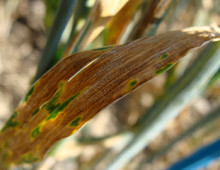Over the past few years, the U.S. Department of Energy’s Joint Genome Institute has taken up the challenge to sequence additional starches that could make a significant difference in developing nations where corn and soybean are less important than such staples as foxtail millet, sorghum and cassava. Such crops, if engineered to be more nutritious,…
Mycosphaerella project in Media Newswire
Enzymes often break down plant cell walls and begin removing nutrients, leading to the plant’s death. M. graminicola, however, enters the plant through stomata, small pores in the surface of leaves that allow for exchange of gases and water. Goodwin said the fungus seems to lay dormant between plant cells, avoiding detection. It later infects…
Mycosphaerella genome project in Agricultural Research
The pathogen that causes the disease, Mycosphaerella graminicola, has a long “silent period,” a latent stage during which it takes nutrition from the living plant and evades the host plant’s natural defenses. Scientists previously did not have a good understanding of how the organism infects wheat, or how the wheat plant itself resists the pathogen….
Mycosphaerella genome project in Farmers Guardian
SCIENTISTS have cracked the genetic code of septoria tritici – the most important foliar disease of wheat in the UK – and in doing so have gained an insight into how the disease is able to evade wheat’s natural defences. The researchers, who were funded by the BBSRC and others, hope the study, which reveals…
First Finished Filamentous Fungus
An international consortium of scientists, including scientists from DOE JGI, have published the analysis for Mycosphaerella graminicola, the first filamentous fungus to be fully finished. Having the 39.7 million nucleotide genome available will enable researchers to learn more about the methods plant pathogens use to attack and damage crops, including those being considered for use…
Tagging coral proteins adapting to global climate change
Over the past two decades, scientists have linked the decrease in the pH levels of the global oceans and the corresponding slowdown in coral growth to the increasing levels of carbon dioxide trapped in the atmosphere and which in turn are being absorbed in the ocean. As coral reefs are the primary habitat for several…
Poplar rust genome project on Wisconsin Ag Connection
The sequencing of the genetic codes of wheat stem rust pathogen (Puccinia graminis) and poplar leaf rust pathogen (Melampsora larici-populina) is expected to help researchers develop control strategies to address worldwide threats to wheat fields and tree plantations. The study, published in the Proceedings of the National Academy of Sciences, was a six-year collaborative effort…
A.niger genome project on The Bioenergy Site
Published online ahead of print May 4, 2011 in Genome Research, a team led by Scott Baker of the Pacific Northwest National Laboratory compared the genome sequences of two Aspergillus niger strains to, among other things, better harness its industrial potential in biofuels applications. As more than a million tons of citric acid are produced annually, the production…
How salt-loving archaea can assist with biofuel production
Halophilic bacteria thrive in environments with very high concentrations of salt such as the waters and sediments of salt lakes and saline soils. One of the reasons why the DOE JGI has been sequencing halophiles under the Genomic Encyclopedia of Bacteria and Archaea (GEBA) project and the Community Sequencing Program is because they have salt-adapted…
JGI Science @ the Lesher: “The Deal with Microbes” video
The May 9, 2011 event at the Lesher Center for the Arts in downtown Walnut Creek featured Jonathan Eisen and Rachel Mackelprang of DOE JGI, and Terry Hazen of Berkeley Lab. KTVU Health and Science Editor John Fowler served as panel moderator. (Note: There’s a short delay before the video starts at the 20-second mark.)…

